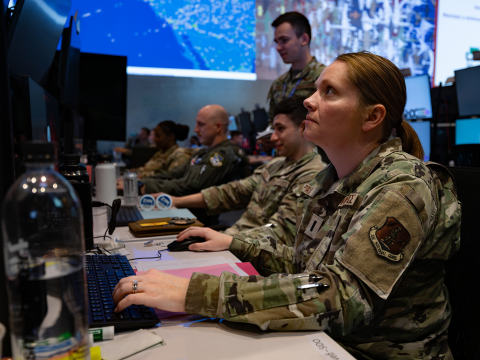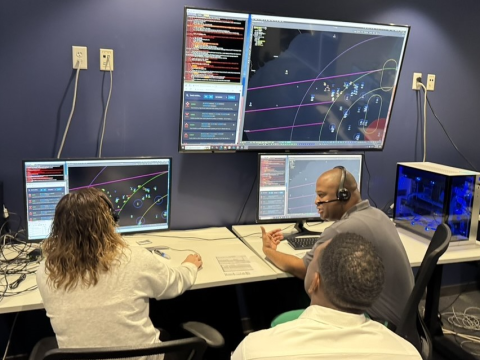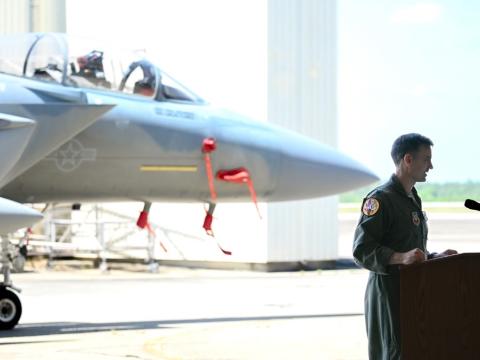Command and Control Connect In Air Force Electronics Center
Joint experiments, intelligent agents and simulation come together to lay the groundwork for future battlespace information systems.
U.S. Air Force experts are introducing new methods of developing, deploying and exploiting information systems in the joint environment. However, instead of inventing new technologies for leap-ahead capabilities, planners now are innovating system architectures and operational methodologies to provide more efficient and effective networking and information access.
A joint experiment this summer addresses many issues regarding command and control (C2) connectivity in a theater of operations. Among these is how to access key databases without smothering vital bandwidth with unnecessary information traffic. Amidst these challenges, simulation is emerging as the likely glue to bringing together diverse platforms and their information resources.
These promising lines of inquiry are developing from work at the U.S. Air Force’s Electronic Systems Center (ESC), based at Hanscom Air Force Base, Massachusetts. The center’s main focus is on three related areas: the Joint Expeditionary Force Experiment (JEFX), which will examine integrating C2; the joint battlespace infosphere (JBI), which aims to allow system operators to couple C2 systems for efficient data access; and simulation-based acquisition.
All three efforts will manifest themselves in the JEFX, states Col. Edward L. Mahan, Jr., USAF, director for the integrated command and control program office at the ESC. This summer’s JEFX process will differ from its predecessors in that the center “finally has the processes down” for new ways of doing business for the 2005 Air Force, he offers. Past sessions tended to feature too many process experiments and initiatives, which made it difficult to assess results and do justice to the entire experiment. This year’s experiment is the right size, and its processes have been refined to enable a more smoothly flowing exercise, he emphasizes.
Col. Mahan describes the ESC’s JBI concept as “the way of the future for taking legacy systems and getting them to talk to one another.” It enables the Air Force to use new technologies as middleware “in a publish-and-subscribe manner” that makes legacy data available in a single display, he says.
The key to tying together these and other elements may be simulation-based acquisition. The center is studying this approach as a possible means to meld C2 architectures into a single entity as well as integrate them with platforms early in the developmental process. “Simulation-based acquisition may—and that remains to be seen—fundamentally influence the way you do business,” declares Col. David Tillotson III, USAF, chief of the experimentation division for the integrated command and control program office at the ESC.
Col. Tillotson notes that the ESC has brought two JEFX issues to the fore. One is to engage in early concept of operations development. Planners had most of the technology under control for this summer’s experiment, but the operations community needed more time to work out concepts for the new technology before entering the experimentation phase. Concurrently, technologists are speeding their technologies into place earlier to enable any necessary refinements before the experiment begins.
The second point involves transitioning lessons learned into the field. One key result of last year’s JEFX was that the Air Force chief of operations was directed to examine implementing the distributed, collaborative C2 architecture for strategic nodes. That exercise and its predecessor, EFX 98, experimented with this idea. However, Col. Tillotson admits that the center’s overall track record in that area has not been very successful. This year, the center is working with a group under the experimentation team to focus on transitioning both technologies and processes to the field after the experiment. One change that will aid in this effort is that the JEFX becomes biennial after this year, so the center will have more time to put its lessons learned into play.
Three major elements figure into this year’s JEFX. First, based on the experiment’s theme of agile combat support, the center is focusing on tying the support community to warfighting execution, Col. Tillotson relates.
The second key aspect involves a more dynamic approach to engaging targets in the battlespace. This comprises better management of intelligence, surveillance and reconnaissance assets as well as redirecting the force in a more flexible manner than does the current structured air tasking order. This would permit forces to respond more dynamically to targets as they emerge, Col. Tillotson notes.
The third item involves the JBI. When the center begins the JEFX, it is operating among all of the Air Force and other service C2 systems. As it begins to bring these systems together, it must determine the correct architectural approach. Col. Tillotson explains that designing systems to be tightly coupled and integrated can improve performance, but it also brings the drawback of difficulty in sustaining, maintaining and upgrading these systems. Configuration control becomes especially difficult while maintaining the necessary tight linkages, he adds.
The JBI approach, with its notion of intelligent agents querying existing databases and creating databases on demand, provides an opportunity to take advantage of information technology upgrades while also continuing to exchange information among the varied C2 systems and databases, Col. Tillotson allows. “We see that as a very key and essential piece in our way ahead,” he declares.
The Air Force defines the early stage of this evolving technology as the Wright Flyer JBI, which will debut at the JEFX in September. As this technology continues to develop, it will enable easier integration of interoperable command and control systems.
Col. Mahan explains that the center currently is building the Wright Flyer JBI prototype in its command and control unified battle laboratory. The goal is to define it as a publish-and-subscribe operation for obtaining instantaneous feedback from intelligence, surveillance and reconnaissance data. This provides information on coverage areas, the types of coverage and any needs for reallocating assets to change that area coverage.
A commander, for example, might observe a new target of opportunity for surveillance and choose which intelligence asset to dedicate to that target. Similarly, the JBI could notify the commander when an object or area changes and recommend asset reapportionment to cover that area.
Col. Tillotson explains that the JBI will use intelligent agents with existing databases to publish information designated in advance by the warfighter as necessary. The commander would establish a rule set, which would enable the databases to be routinely queried and their information presented to the decision maker as a routine update process.
The new aspect of this approach is that, instead of trying to tightly couple all of these elements into a welded database environment, the JBI would use a combination of these intelligent agents, query tools and Web browsers to seek out existing information and bring it into a new database that catalogs the information. As a situation changes, the warfighter could use the same process to query anew or establish a new rule set for additional updates.
“It’s a combination of ‘smart push’ and ‘intelligent pull’ without fundamentally attacking the architecture of existing C2 systems,” Col. Tillotson notes. “It basically is information brokering and information management.”
In addition to extracting information from databases, the Wright Flyer JBI would pull data directly from sensor platforms. It would be able to deliver this information to commanders at various echelons without fundamentally altering their operating systems at the corps level, Col. Tillotson says.
One issue to be determined in the Wright Flyer JBI is how to make the intelligent agents perform as needed with a reasonably robust rule set. Another is to determine which intelligence, surveillance and reconnaissance assets should be tapped for information. Col. Tillotson notes that the intelligence community already has several rear-to-forward pushes for some situations. One option would be to limit the JBI query to theater assets and to have forward assets query rear assets on a separate channel.
Col. Tillotson adds that, if the JBI approach has merit, researchers then must consider its effect on bandwidth demand. Independent of the JBI, JEFX 2000 will be seeking new techniques to manage bandwidth more effectively.
Much concept work remains in this arena. Enabling the disparate databases to communicate with one another opens up flexibility in the C2 architecture for development purposes, Col. Tillotson notes. This would help alleviate some bandwidth issues.
Col. Mahan adds that this summer’s JBI version is just a preliminary step. “What we have done is build a scenario that will be somewhat interactive,” he states. “It is not as interactive as it will be in the long term because Wright Flyer implies just what it is—something to show that we can do it.” He continues that the center aims to tie into the existing infrastructure during the JEFX to obtain intelligence, surveillance and reconnaissance data for display with the JBI. “The ‘publish’ aspect involves knowing every time something moves in a particular area,” Col. Mahan explains.
“This is very conceptual,” he emphasizes. “The hope is that what comes out of JEFX demonstrates that there is the capability to use this kind of technology. Then, we must expand our vision to figure out how we can work collaboratively with industry, the battle labs, the Air Force research labs, the test community and the customer to enable this technology and use it.”
These diverse C2 systems could owe their future design to simulation-based acquisition. This methodology has been running in some U.S. Defense Department areas for several years, but the ESC is working to advance it through several activities that already have reduced acquisition time. While simulation-based acquisition has taken root in the joint strike fighter (JSF) program, Col. Mahan relates that the center has brought it into the Air Force Materiel Command, which has selected the ESC as a center of excellence for simulation-based acquisition.
In the future, this discipline would be most useful in command and control, Col. Mahan offers. Simulation-based acquisition could be applied to meld system architectures into an integrated architecture. If performed correctly, it can allow officials to determine if they have gaps in their developmental efforts.
The center is not new to simulation-based acquisition. Its work in the Cobra Gemini program involved model-reference technology. Col. Mahan credits Lt. Gen. Leslie F. Kenne, USAF, ESC commander, with increasing the center’s emphasis on this approach and improving its efforts as a result of her experience with the JSF program.
Officials at programs such as the joint surveillance target attack radar system (JointSTARS), the airborne warning and control system (AWACS) and the integrated broadcast system are looking to incorporate this capability, Col. Mahan states. Now, the operational community is examining how to exploit simulation-based acquisition, he adds.
During the Air Force’s work on building its air operations centers as weapon systems, the ESC performed some simulation-based acquisition analysis. The procedure revealed some duplicated areas, and the simulation-based acquisition helped clarify the complete process. This permitted program personnel to make necessary adjustments and refinements.
By setting up its center of excellence for simulation-based acquisition, the ESC is laying the groundwork to cut across all of the product centers and administration and logistics centers, Col. Mahan says. This will establish standard tools and a common environment from which all participants can work, he adds.
“If we’re going to be successful in the future, we must figure out collectively how to work with industry and how to leverage the business model that industry uses today with what we’re doing in the command and control information technology world,” Col. Mahan declares.
Col. Tillotson notes that these models can be used to validate alternatives—to do the “what-ifs” of both the process and the system design. “We can actually insert in models of the integrated command and control system both the process and the systems that support the process,” he says.
This was done for the JSF program office on a smaller scale within the JEFX. The center ran extensive modeling and simulation work for the JEFX because it is both a live and a constructive experiment. For this year’s JEFX, the ESC will insert the future fighter as a constructive entity because the aircraft is yet to be built.
Col. Tillotson relates that the ESC has found that it can experiment with concepts of operations by knowing a bit about the aircraft’s capabilities as well as the center’s capabilities to provide tasking and response, and to simulate and model all of the interfaces. “The result is that we then are influencing system design both for the JSF itself and also for the C2 system with which it will have to interface,” he says. “There is a growing recognition within the Air Force that it cannot treat the C2 system as an entity unto itself but as an entity that affects all the various systems and platforms that are attached to it.”




Comments